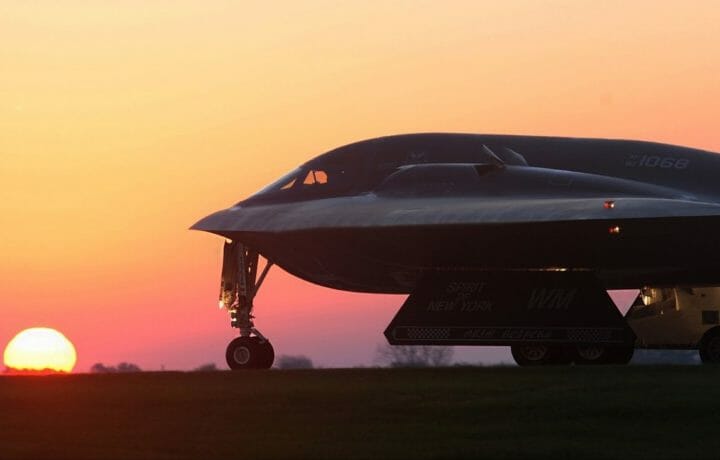In the coming years, the United States Air Force will transform to a two-bomber fleet made up of the heavily modified Cold War-era B-52, along with the now under development B-21 Raider. As the stealth-capable Raiders enter service, the Air Force will begin to phase out the aging B-1B Lancers and slightly newer B-2 Spirits. A second prototype is reported to be under construction, and according to Northrop Grumman, the lead contractor on the program, “The B-21 Raider will be capable of penetrating the toughest defenses to deliver precision strikes anywhere in the world.”
With the arrival of the new, and more importantly significantly larger, B-21 Raiders, the Air Force requires facilities that can best accommodate the bomber.
The Main Operating Base
In March 2019, the secretary of the Air Force announced that Ellsworth Air Force Base (AFB), South Dakota was selected as the preferred location, and Dyess AFB, Texas, a reasonable alternative, for the first B-21 Main Operating Base (MOB). Whiteman AFB, Missouri has been named as the third MOB for the Raider. A final decision will be made later this summer.
The B-21 Program Office has already been testing various prototype shelters to identify the most effective and affordable designs that could be used across all three B-21 MOBs, the depot, and even at forward operating locations. The B-21 team had considered installing the temporary prototype shelters at each of the three planned B-21 MOBs, but it was determined that Ellsworth AFB had weather conditions that offer the opportunity to collect the most diverse amount of data.
“Environmental Protection Shelters help extend the life of the aircraft and reduce required maintenance by limiting UV exposure, limiting snow accumulation and melt, and limiting icing/de-icing operations experienced by the aircraft over time,” said Col. Derek Oakley, B-21 Integration and System Management Office director. “These shelters also help us generate sorties more quickly by eliminating the need to always have to move aircraft in and out of hangars.”
Such shelters are meant to complement, not replace, maintenance hangars expected at each MOB.
“Major maintenance activities will still be performed indoors in hangars, but the B-21 Raider design will also provide us the flexibility to perform routine maintenance right on the flightline,” added Oakley.
Beyond the prototype Environmental Protection Shelters activities, the Air Force also continues to prepare for the broader military construction requirements associated with B-21 beddown. New facilities to operate and sustain a low observable bomber will have to be built at the three planned B-21 MOBs as well as the depot. Planning and design is now ongoing for facilities such as a Low Observable Maintenance Hangar, General Maintenance Hangar, and other operations and maintenance structures.
Beddown Construction Services
It will still be a few more years until the Northrop Grumman B-21 Raider bomber begins to enter service, but the U.S. Army is already showing some significant inter-service support to the Air Force. This month, the U.S. Army Corps of Engineers (USACE) awarded three companies positions on a potential seven-year, $200 million contract to help the Air Force’s Civil Engineering Centers plan and build facilities necessary to accommodate the aircraft.
Jacobs, the FSB-Pond joint venture, and Burns & McDonnell are the three firms that will cooperate on the planning, design, and construction orders under the firm-fixed-price (FFP) contract, according to the DoD. USACE had reportedly received 10 bids for the AFCEC B-21 beddown mission via an online solicitation process.
Following the conclusion of the National Environmental Protection Act process, which is expected to be completed this summer, construction for permanent facilities will begin. Work to conclude by March 18, 2028.
Power Projection
The B-21 is a heavy stealth strategic bomber that has its roots in the Long Range Strike Bomber program (LRS-B), an early to mid-2010s procurement program for a long-range, nuclear-capable strike bomber. Along with the Russian PAK DA and Chinese H-20 counterparts, the B-21 is a flying wing subsonic bomber that has put an emphasis on stealth, penetration capabilities, and prodigious payload capacity over raw speed and supermaneuverability.
The B-21 Raider’s currently confirmed weapons reportedly include the JASSM-ER stealthy cruise missile, the 30,000 pound GBU-57 Massive Ordnance Penetrator “bunker buster” bomb, and GBU-31 Joint Directed Attack Munition (JDAM) satellite-guided bomb.
Additionally, the B-21’s armaments suite is being designed with a focus on payload and configuration flexibility to accommodate a wide range of roles and mission requirements, though the full extent of its battlefield capabilities has yet to be revealed.




